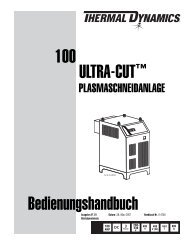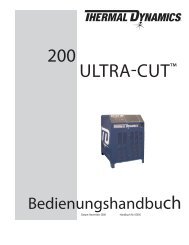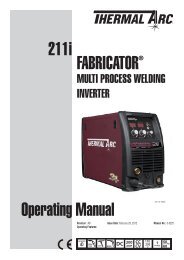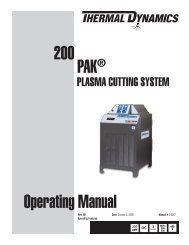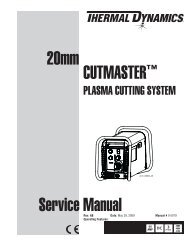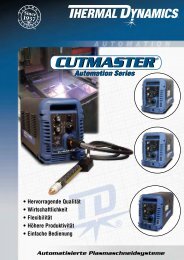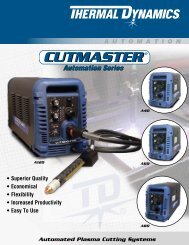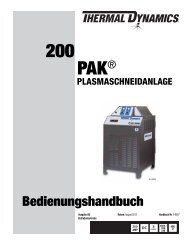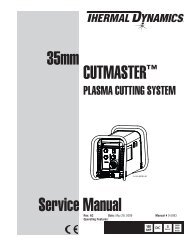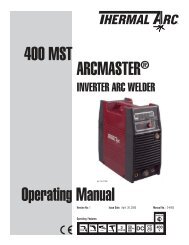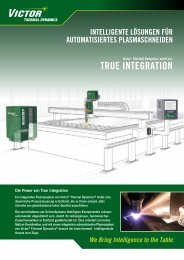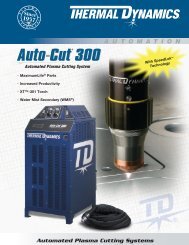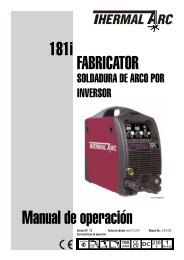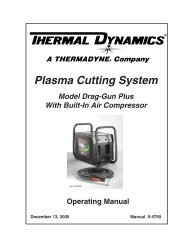CutMaster True Service Manual - Victor Technologies - Europe
CutMaster True Service Manual - Victor Technologies - Europe
CutMaster True Service Manual - Victor Technologies - Europe
You also want an ePaper? Increase the reach of your titles
YUMPU automatically turns print PDFs into web optimized ePapers that Google loves.
4T.05 Gouging<br />
! WARNINGS<br />
Be sure the operator is equipped with proper<br />
gloves, clothing, eye and ear protection and that all<br />
safety precautions at the front of this manual have<br />
been followed. Make sure no part of the operator’s<br />
body comes in contact with the workpiece when<br />
the torch is activated.<br />
Disconnect primary power to the system before<br />
disassembling the torch, leads, or power<br />
supply.<br />
CAUTION<br />
Sparks from plasma gouging can cause damage<br />
to coated, painted or other surfaces such as glass,<br />
plastic, and metal.<br />
Check torch parts. The torch parts must<br />
correspond with the type of operation. Refer to<br />
Section 4T.07, Torch Parts Selection.<br />
Gouging Parameters<br />
Gouging performance depends on parameters<br />
such as torch travel speed, current level, lead angle<br />
(the angle between the torch and workpiece), and<br />
the distance between the torch tip and workpiece<br />
(standoff).<br />
CAUTION<br />
Touching the torch tip or shield cup to the work surface<br />
will cause excessive parts wear.<br />
Torch Travel Speed<br />
NOTE<br />
Refer to Appendix Pages for additional information<br />
as related to the Power Supply used.<br />
Optimum torch travel speed is dependent on current<br />
setting, lead angle, and mode of operation (hand or<br />
machine torch).<br />
Current Setting<br />
Current settings depend on torch travel speed,<br />
mode of operation (hand or machine torch), and the<br />
amount of material to be removed.<br />
Lead Angle<br />
CUTMASTER 25mm<br />
The angle between the torch and workpiece depends<br />
on the output current setting and torch travel speed.<br />
The recommended lead angle is 35°. At a lead angle<br />
greater than 45° the molten metal will not be blown<br />
out of the gouge and may be blown back onto the<br />
torch. If the lead angle is too small (less than 35°),<br />
less material may be removed, requiring more passes.<br />
In some applications, such as removing welds or<br />
working with light metal, this may be desirable.<br />
A-00941_AB<br />
Torch Head<br />
Workpiece<br />
Standoff Height<br />
Gouging Angle and Standoff Distance<br />
Standoff Distance<br />
<strong>Manual</strong> 0-5081 4T-7 OPERATION<br />
35°<br />
The tip to work distance affects gouge quality and<br />
depth. Standoff distance of 1/8 - 1/4 inch (3 - 6<br />
mm) allows for smooth, consistent metal removal.<br />
Smaller standoff distances may result in a severance<br />
cut rather than a gouge. Standoff distances greater<br />
than 1/4 inch (6 mm) may result in minimal metal<br />
removal or loss of transferred main arc.<br />
Slag Buildup<br />
Slag generated by gouging on materials such as carbon<br />
and stainless steels, nickels, and alloyed steels,<br />
can be removed easily in most cases. Slag does not<br />
obstruct the gouging process if it accumulates to the<br />
side of the gouge path. However, slag build - up can<br />
cause inconsistencies and irregular metal removal if<br />
large amounts of material build up in front of the<br />
arc. The build - up is most often a result of improper<br />
travel speed, lead angle, or standoff height.



